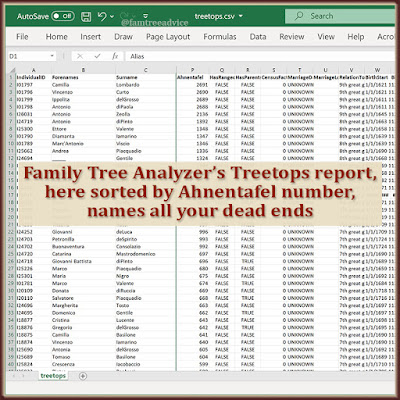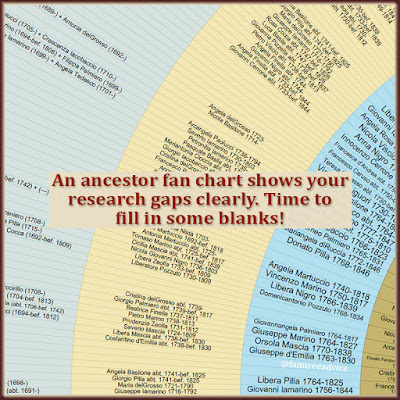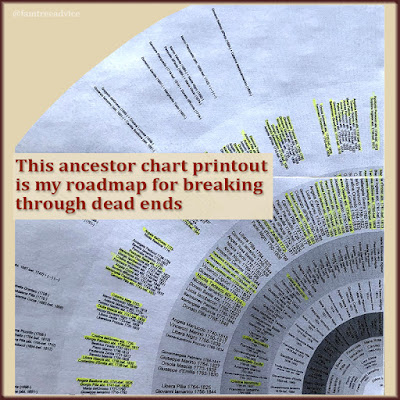My family tree has exploded to include more than 26,000 people. My grand mission—to connect Grandpa's entire town—is making it grow faster than ever.
When you've done a ton of research, it can be hard to see where your tree needs more work. And that's exactly what I want to know. Where should I focus to get the most bang for the buck?
I need a way to see exactly where the gaps are in my family tree.
Three ways to visualize these research gaps come to mind.
1. Grandparent Chart
My grandparent chart spreadsheet lists all my direct ancestors by their Ahnentafel number. I use color-coding to separate 4 main branches—1 color for each of my grandparents.
I've been good about keeping this spreadsheet up to date. But when I get to the higher generations, it takes a lot of scrolling to see where the gaps are. This tool isn't quite right for this task.
 |
| This Ahnentafel chart keeps tabs on the direct ancestors in my family tree. But it doesn't highlight the dead ends very well. |
2. Family Tree Analyzer
I knew that the free Family Tree Analyzer tool has a report called Treetops. It lets you see the earliest known members of your tree on different branches. These are the people with no ancestors in your family tree. They are each the "treetops" of a particular branch.
This report still didn't give me the visualization I wanted. I was hoping to see the dead ends, to clearly see the gaps in my research.
 |
| The Treetops report in Family Tree Analyzer finds all the dead ends in your genealogy research. But it doesn't show where each person fits. |
3. Family Tree Fan Chart
I thought a family tree chart might be just what I needed. I could have used the charting functionality of my Family Tree Maker software, but colors might be helpful.
I'd been thinking of revisiting Charting Companion by Progeny Genealogy to see if I wanted to buy it. Now was the perfect time to kill two birds with one stone.
I downloaded the free trial version to see what was new since I owned a very early version years ago.
After looking at a few types of charts, I realized a fan chart of all my direct ancestors is exactly what I need for this project.
 |
| An ancestor fan chart is just the thing to provide an instant, visual guide for your ongoing family tree research. |
I created a chart of 9 generations of my ancestors. I printed it to a PDF so I can zoom in to read names, and I can see the color banding. I also printed a copy to my black and white laser printer. I trimmed the 4 pages and taped them together to make a big chart.
On the paper version, I used a highlighter pen to mark the treetops—the oldest known ancestor on a branch of my family tree.
Now I have a true visualization of the branches needing more research.
Each branch has its own challenges. On my maternal grandmother's branch, my research is cut off because there are very few vital records available for their Italian hometown. On other branches I've identified my 7th great grandparents, born between the late 1600s and early 1700s. Until I can access earlier church records, this is as far as I can go.
This exercise got me exactly what I wanted. It's an easy-to-read chart of my direct ancestors most in need of more research.
 |
| My ancestor fan chart, with all the treetops highlighted, becomes a road map for my family tree research. |
My quest to piece together Grandpa's entire town is wonderful, but enormous. If I could focus that project on my direct ancestors first, it'd be more fun and inspiring. Three quarters of my paternal ancestors came from Grandpa's hometown. I can try to break through those treetops while working on Grandpa's hometown project at the same time.
Last week I finished a major task so I could work on Grandpa's hometown project. I renamed every available vital record from the town (Colle Sannita, Benevento, Italy) to include the name of the subject. Then I made an easily searchable text file and Excel file of all the data and published it.
Those renamed files make it as easy as it can possibly be for me to break through three quarters of my paternal treetops. If I can't find what I need, then I've done all I can with what's available.
Do you know where all your treetops are? Have you done all you can to expand them?


